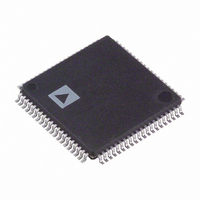ADV7194KSTZ Analog Devices Inc, ADV7194KSTZ Datasheet - Page 20

ADV7194KSTZ
Manufacturer Part Number
ADV7194KSTZ
Description
IC ENCODER VIDEO EXT-10 80-LQFP
Manufacturer
Analog Devices Inc
Type
Video Encoderr
Datasheet
1.ADV7194KSTZ.pdf
(69 pages)
Specifications of ADV7194KSTZ
Applications
DVD, PC Video, Multimedia
Voltage - Supply, Analog
3.3 V ~ 5 V
Voltage - Supply, Digital
3.3 V ~ 5 V
Mounting Type
Surface Mount
Package / Case
80-LQFP
Input Format
Digital
Output Format
Analog
Supply Voltage Range
3.15V To 3.6V
Operating Temperature Range
0°C To +70°C
Tv / Video Case Style
LQFP
No. Of Pins
80
Msl
MSL 1 - Unlimited
Svhc
No SVHC
Rohs Compliant
Yes
Lead Free Status / RoHS Status
Lead free / RoHS Compliant
For Use With
EVAL-ADV7194EB - BOARD EVAL FOR ADV7194
Lead Free Status / RoHS Status
Lead free / RoHS Compliant, Lead free / RoHS Compliant
Available stocks
Company
Part Number
Manufacturer
Quantity
Price
Company:
Part Number:
ADV7194KSTZ
Manufacturer:
ADI
Quantity:
393
Company:
Part Number:
ADV7194KSTZ
Manufacturer:
ADI
Quantity:
717
Company:
Part Number:
ADV7194KSTZ
Manufacturer:
Analog Devices Inc
Quantity:
10 000
Part Number:
ADV7194KSTZ
Manufacturer:
ADI/亚德诺
Quantity:
20 000
ADV7194
YUV LEVELS
This functionality allows the ADV7194 to output SMPTE levels
or Betacam levels on the Y output when configured in PAL or
NTSC mode.
Betacam
SMPTE
MII
As the data path is branched at the output of the filters the luma
signal relating to the CVBS or S-Video Y/C output is unaltered.
It is only the Y output of the YCrCb outputs that is scaled.
This control allows color component levels to have a peak-peak
amplitude of 700 mV, 1000 mV or the default values of 934 mV
in NTSC and 700 mV in PAL. (Mode Register 5.)
20-/16-BIT INTERFACE
It is possible to input data in 20-bit or 16-bit format. In this
case, the interface only operates if the data is accompanied by
separate HSYNC/VSYNC/BLANK signals. Twenty-bit or 16-
bit mode is not available in Slave Mode 0 since EAV/SAV timing
codes are used. (Mode Register 8.)
4
It is possible to operate all six DACs at 27 MHz (2× Oversam-
pling) or 54 MHz (4× Oversampling).
The ADV7194 is supplied with a 27 MHz clock synced with the
incoming data. Two options are available: to run the device
throughout at 27 MHz or to enable the PLL. In the latter case,
even if the incoming data runs at 27 MHz, 4× Oversampling
and the internal PLL will output the data at 54 MHz.
NOTE
In 4× Oversampling Mode the requirements for the optional
output filters are different than from those in 2× Oversampling.
(Mode Register 1, Mode Register 6.)
–30dB
MPEG2
0dB
OVERSAMPLING AND INTERNAL PLL
PIXEL BUS
27MHz
6.75MHz
Sync
286 mV
300 mV
300 mV
2
REQUIREMENTS
13.5MHz
FILTER
ENCODER
ADV7194
PLL
CORE
×
54MHz
27.0MHz
2
O
O
N
T
E
R
P
L
A
T
N
I
I
Video
714 mV
700 mV
700 mV
4
REQUIREMENTS
40.5MHz
FILTER
6
D
A
C
O
U
T
P
U
T
S
×
54MHz
OUTPUT
54.0MHz
VIDEO TIMING DESCRIPTION
The ADV7194 is intended to interface to off-the-shelf MPEG1
and MPEG2 Decoders. As a consequence, the ADV7194 accepts
4:2:2 YCrCb Pixel Data via a CCIR-656 Pixel Port and has
several Video Timing Modes of operation that allow it to be
configured as either System Master Video Timing Generator or
a Slave to the System Video Timing Generator. The ADV7194
generates all of the required horizontal and vertical timing periods
and levels for the analog video outputs.
The ADV7194 calculates the width and placement of analog sync
pulses, blanking levels, and color burst envelopes. Color bursts
are disabled on appropriate lines and serration and equalization
pulses are inserted where required.
In addition, the ADV7194 supports a PAL or NTSC square pixel
operation. The part requires an input pixel clock of 24.5454 MHz
for NTSC square pixel operation and an input pixel clock of
29.5 MHz for PAL square pixel operation. The internal hori-
zontal line counters place the various video waveform sections in
the correct location for the new clock frequencies.
The ADV7194 has four distinct Master and four distinct Slave
timing configurations. Timing Control is established with the
bidirectional HSYNC, BLANK and VSYNC pins. Timing Regis-
ter 1 can also be used to vary the timing pulsewidths and where
they occur in relation to each other. (Mode Register 2, Timing
Register 0, 1.)
RESET SEQUENCE
When RESET becomes active the ADV7194 reverts to the
default output configuration (see Appendix for register settings).
The ADV7194 internal timing is under the control of the logic
level on the NTSC_PAL pin.
When RESET is released Y, Cr, Cb values corresponding to a
black screen are input to the ADV7194. Output timing signals
are still suppressed at this stage. DACs A, B, C are switched off
and DACs D, E, F are switched on.
When the user requires valid data, Pixel Data Valid Control is
enabled (MR26 = 1) to allow the valid pixel data to pass through
the encoder. Digital output timing signals become active and
the encoder timing is now under the control of the Timing Regis-
ters. If at this stage, the user wishes to select a different video
standard to that on the NTSC_PAL pin, Standard I
trol should be enabled (MR25 = 1) and the video standard
required is selected by programming Mode Register 0 (Out-
put Video Standard Selection). Figure 36 illustrates the RESET
sequence timing.
2
C Con-













